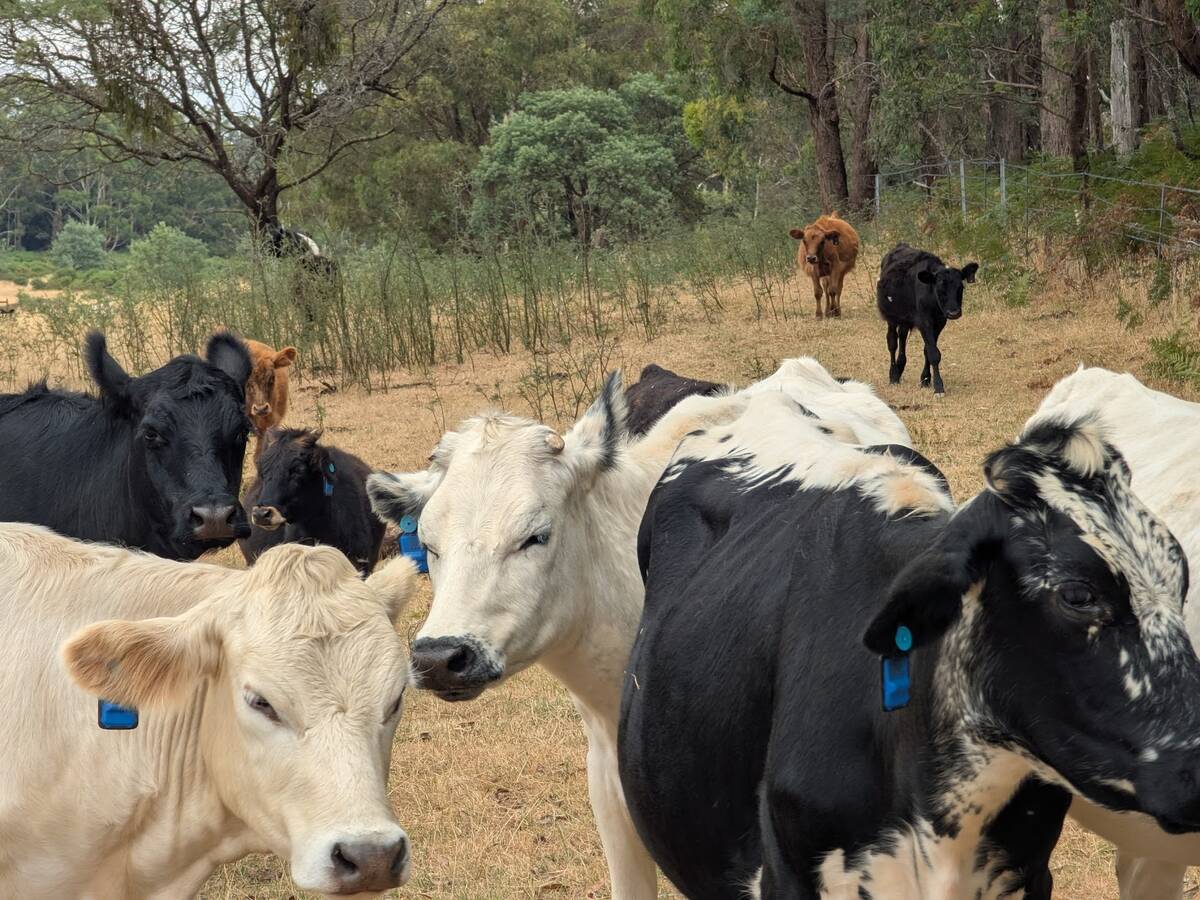University of Saskatchewan researchers have their sights set on an innovative solution for a costly cattle disease.
Infectious bovine keratoconjunctivitis, or pink eye, remains an unpredictable, highly contagious disease that can lead to large outbreaks within herds, and current treatment options are inadequate.
This prompted researchers at the university’s Vaccine and Infectious Disease Organization (VIDO), an interdisciplinary centre that researches both animal and human pathogens to create vaccines, to explore the possibility of a more ocular vaccine option delivered through eye drops that may be more effective.
Read Also

Australian company brings ear-tag tech to Canadian pastures
With Smart Paddock, beef farmers and ranchers can track their cattle through GPS technology
“We had heard from many ranchers that this is still an important problem, and especially as we here on the Prairies have more droughts and dust and very hot summers, those are all conditions that are predisposing to pink eye,” says Dr. Philip Griebel, VIDO researcher.
Young calves on pasture tend to be the most susceptible to pink eye, though recent evidence shows the disease is occurring in weaned calves and yearlings more often. The infection can lead to permanent scarring of the eye’s surface, reducing vision. In severe cases, the animal may lose its vision entirely. It can also affect one eye before spreading to the other, compromising vision in both eyes.
“It’s a very important animal welfare issue because any infection in the eye is very painful,” says Griebel. “Studies have been done to show that suckling beef calves on pasture, if they are affected with pink eye, their weight gain may be reduced as much as 30 to 45 lbs.”
Treating the disease can be challenging if an outbreak occurs when cattle are on pasture. Because the infection can move slowly through a herd, it may be necessary to bring cattle in numerous times for treatment, and some researchers speculate this may increase its transmission between animals.
There are several factors that can increase susceptibility to pink eye, some of which are out of a producer’s control. For example, hot, dry summers can lead to sun damage and scratches from dust or dirt on the surface of the eye, raising the risk of infection. Management conditions that can contribute to the risk of infection include damage to the eye from dusty or coarse forage during winter feeding.
Knowing how these factors can increase the risk of pink eye is tied to researchers’ improved understanding of the two primary bacteria present in infected cattle, Moraxella bovis and Moraxella bovoculi. Two proteins in these bacteria, he explains, play a major role in causing the infection.
“One of the proteins is involved in enabling the bacteria to attach and stay very close, firmly attached to damaged surfaces in the eye, so an attachment protein,” he says.
“The other thing these bacteria do is they actually secrete a toxin, what’s called a cytotoxin, so a soluble protein that actually damages cells on the surface of the eye. So that’s how they exacerbate or increase the damage in the eye if there is sun damage or physical trauma from dust or tall grass.”
Researchers have learned that these bacteria are normally found within the microbiome in the nose of cattle. “It isn’t that the bacteria by themselves are sufficient to cause disease,” he says. “Environmental factors seem to be important as well in helping these bacteria really increase their numbers in the eye.”
Current preventative options inadequate
“With many vaccines, it takes at least two to three weeks to induce a protective level of immunity, and with our research we’ve actually shown with the vaccine that’s out there, to induce a good immune or antibody response with the vaccine requires two injections,” he says.
“If a herd has a pink eye outbreak in June or July, by the time they would get the vaccinations completed, that could take four to six weeks, they may be all the way through their outbreak before they would actually be starting to induce protective immunity.”
Despite current vaccines in North America being what Griebel calls “a sub-optimal tool,” producers spend more than $10 million each year on them. “To me it’s very concerning if producers are using vaccines as a tool but we think they’re not an effective tool,” he says.
With this knowledge, Griebel and his team began evaluating the effectiveness of the one commercially available vaccine in Canada. This included examining if it induced an immune response only in the blood or if it induced enough antibody production in the eye or nose to protect against infection. Results showed that after two doses, this vaccine increased the immune response in the blood but not in the eyes or nose.
“That suggested to us that because the type of antibodies present in blood are very different from the type of antibodies that are secreted in the nose or in the tears …inducing antibody in blood does not really provide protection in the nose or the eye.”
Dr. Paola Elizalde, who was Griebel’s graduate student at the time, used these results to study local antibody development in calves, suspecting that the antibody response to the bacteria increases with age, as younger calves tend to be more at risk for the infection. Elizalde found that healthy yearlings with no history of pink eye had high levels of antibodies against both Moraxella bovis and Moraxella bovoculi in their eyes and nose.
“Their immune system is seeing these bacteria even when they are healthy, and they are responding, and that may explain why older animals are quite resistant to pink eye,” says Griebel.
This was compared to calves younger than two to three months old, whose local antibody development against the bacteria is at a much lower level. “This suggested to us that a vaccine may be beneficial if we can vaccinate earlier in life and accelerate the development of antibody to these bacteria that infect the eye,” he says.
To most effectively induce a local immune response in the eye, the vaccine would need to be administered directly to the eye via eye drops. Griebel’s team has started considering the viability of developing an ocular vaccine. The challenge was to ensure that a vaccine given through eye drops would be safe and not damage the surface of the eye. By studying the development of the eye’s local immune response, Elizalde learned this would be a possibility.
“There’s very little development of the immune system in the newborn calf … but by the time they’re six to eight weeks of age, there’s very good development of the immune system surrounding the eye, in the eyelid itself,” says Griebel. “Vaccinating calves at turnout or branding in the spring, when they’re six to eight weeks of age, before they go to pasture would be feasible.”
Safety trials underway
Dr. Suresh Tikoo, a VIDO researcher, created a new vaccine delivery system using eye drops for these trials, “based on a virus that is commonly found in cattle but that is not pathogenic — it does not cause tissue damage,” says Griebel. “We are thinking of using that virus to deliver the parts of the bacteria that we think we need an immune response to, to prevent infection.”
In addition to testing the safety of this delivery system, the researchers are evaluating whether this expresses enough of the foreign protein to induce a strong local antibody response in the eye.
“When we give an injectable vaccine, often it takes three to five weeks to develop a protective immune response,” he says, citing the slower speed of the antibody response in the blood compared to that of the eye and nose. With intranasal vaccines for calves, for example, a local antibody response is usually seen within five to seven days.
The goal is to induce this speedy immune response in the eye with the ocular vaccine within five to 10 days. This timing would allow the vaccine to be used in response to an outbreak, providing protection for uninfected cattle and those with only one eye infected, in addition to using it as a preventative measure.
“That will be a major focus of our research, really looking at how rapidly we can induce immune responses. If our ocular vaccine delivery system is safe, then the next question is how quickly can we induce immune responses?”
Results for the current trial are expected in early 2022, and if this delivery system results in no damage to the eye, Griebel and his team will then begin developing the actual vaccine.
“If we have a safe vaccine delivery system, it induces rapid immune responses, our next step will be working with Dr. Tikoo to … construct vaccine delivery systems that encoded these bacterial proteins, and that would really be the vaccine then specific for pink eye.”

















